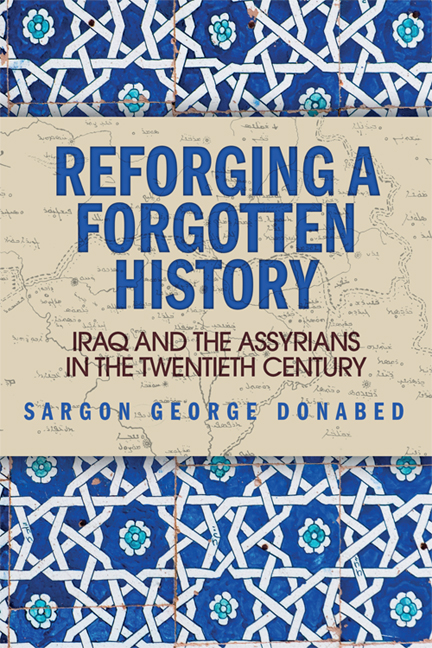Book contents
- Frontmatter
- Contents
- List of Figures
- List of Tables
- Abbreviations
- Acknowledgements
- Dedication
- Map
- Introduction
- 1 Integrating the Assyrian Question
- 2 Framing the Assyrian Narrative: Late Nineteenth and Early Twentieth Century
- 3 Iraq: Building a ‘Nation’-State
- 4 The Birth of the Republic and an Autonomist Struggle
- 5 Enduring Discord: Political Machinations and Border Clearings
- 6 New Movements and War on the Horizon
- 7 State Formation, State-building and Contentious Pluralism
- 8 Conclusion
- Glossary
- Appendix A Village Data
- Appendix B Documents Concerning Cultural and Political Organisations
- Bibliography
- Index
7 - State Formation, State-building and Contentious Pluralism
Published online by Cambridge University Press: 05 September 2016
- Frontmatter
- Contents
- List of Figures
- List of Tables
- Abbreviations
- Acknowledgements
- Dedication
- Map
- Introduction
- 1 Integrating the Assyrian Question
- 2 Framing the Assyrian Narrative: Late Nineteenth and Early Twentieth Century
- 3 Iraq: Building a ‘Nation’-State
- 4 The Birth of the Republic and an Autonomist Struggle
- 5 Enduring Discord: Political Machinations and Border Clearings
- 6 New Movements and War on the Horizon
- 7 State Formation, State-building and Contentious Pluralism
- 8 Conclusion
- Glossary
- Appendix A Village Data
- Appendix B Documents Concerning Cultural and Political Organisations
- Bibliography
- Index
Summary
It may be that when we no longer know which way to go that we have come to our real journey. The mind that is not baffled is not employed. The impeded stream is the one that sings.
Wendell BerryEvil does not arrive from outside of our civilization, from a separate realm we are tempted to call ‘primitive’. Evil is generated by civilization itself.
Michael MannHow and why violence is done is a critical question in the case of this research and while violence can have multiple meanings, it is the idea of injustice, or an unjust exercise of power, and how it may be remedied or at least guarded against that defines the so what? of this book. Violence varies in its forms both structurally and individually – physical, cultural, political, academic, spiritual etc. – and includes less-considered emphases such as harm to meaning, content or intent. Yet in every case it is initially a sense of adverse otherisation and secondly a value assessment which leads to violence in thought, word and deed. And while physical harm may be more discernible, injury to meaning harms the spirit or nature of things and occasionally holds a more sinister quality.
There are various determinants for why states and nations (whether ethnic or civic) engage in violent and non-violent homogenisation during the nation- and state-building process. Michael Mann cites nine motives used by perpetrators of violent crimes (including states), most of which can be extended to perpetrators of non-violent crimes: ideology, bigotry, violence for its own sake, fear, careerism, materialism, discipline, comradeship and bureaucracy. Since people are the true power behind the state, individual and professional reasons for homogenisation often overlap through social influence, creating perpetrator campaigns of both violent and non-violent justification often spearheaded by nationalist elites. In many cases, when the victim becomes involved in the nationalist thrust for recognition, they apply similar motives for denying other victims, thus continuing the hierarchy of marginalisation and suffering.
Such homogenisation is also a result of the age of democracy since the notion of rule by the majority began to entwine the demos, ‘all the ordinary people’, with the dominant ethnos or ethnic group.
- Type
- Chapter
- Information
- Reforging a Forgotten HistoryIraq and the Assyrians in the Twentieth Century, pp. 221 - 262Publisher: Edinburgh University PressPrint publication year: 2015



